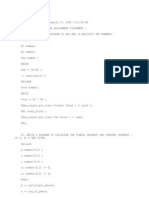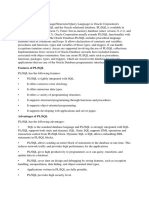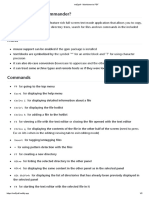PL-SQL - Notes
Uploaded by
weirdwolfvortexPL-SQL - Notes
Uploaded by
weirdwolfvortexPL-SQL
The PL/SQL programming language was developed by Oracle Corporation in the late 1980s as procedural
extension language for SQL and the Oracle relational database. Following are notable facts about
PL/SQL:
PL/SQL is a completely portable, high-performance transaction-processing language.
PL/SQL provides a built-in interpreted and OS independent programming environment.
PL/SQL can also directly be called from the command-line SQL*Plus interface.
Direct call can also be made from external programming language calls to database.
PL/SQL's general syntax is based on that of ADA and Pascal programming language.
Apart from Oracle, PL/SQL is available in TimesTen in-memory database and IBM DB2.
Features of PL/SQL
PL/SQL has the following features:
PL/SQL is tightly integrated with SQL.
It offers extensive error checking.
It offers numerous data types.
It offers a variety of programming structures.
It supports structured programming through functions and procedures.
It supports object-oriented programming.
It supports developing web applications and server pages.
Advantages of PL/SQL
PL/SQL has the following advantages:
SQL is the standard database language and PL/SQL is strongly integrated with SQL. PL/SQL
supports both static and dynamic SQL. Static SQL supports DML operations and transaction
control from PL/SQL block. Dynamic SQL is SQL allows embedding DDL statements in PL/SQL
blocks.
PL/SQL allows sending an entire block of statements to the database at one time. This reduces
network traffic and provides high performance for the applications.
PL/SQL gives high productivity to programmers as it can query, transform, and update data in a
database.
PL/SQL saves time on design and debugging by strong features, such as exception handling,
encapsulation, data hiding, and object-oriented data types.
Applications written in PL/SQL are fully portable.
PL/SQL provides high security level.
PL/SQL provides access to predefined SQL packages.
PL/SQL provides support for Object-Oriented Programming.
PL/SQL provides support for Developing Web Applications and Server Pages.
BASIC PROGRAM STRUCTURE
PL/SQL is a block-structured language, meaning that PL/SQL programs are divided and written in logical blocks of
code. Each block consists of three sub-parts:
S.N. Sections & Description
1
Declarations
This section starts with the keyword DECLARE. It is an optional section and defines all variables,
cursors, subprograms, and other elements to be used in the program.
2
Executable Commands
This section is enclosed between the keywords BEGIN and END and it is a mandatory section. It
consists of the executable PL/SQL statements of the program. It should have at least one
executable line of code, which may be just a NULL command to indicate that nothing should be
executed.
3
Exception Handling
This section starts with the keyword EXCEPTION. This section is again optional and contains
exception(s) that handle errors in the program.
Every PL/SQL statement ends with a semicolon (;). PL/SQL blocks can be nested within other PL/SQL blocks
using BEGIN and END. Here is the basic structure of a PL/SQL block:
DECLARE
<declarations section>
BEGIN
<executable command(s)>
EXCEPTION
<exception handling>
END;
The PL/SQL Delimiters
A delimiter is a symbol with a special meaning. Following is the list of delimiters in PL/SQL:
Delimiter Description
+, -, *, / Addition, subtraction/negation, multiplication, division
% Attribute indicator
' Character string delimiter
. Component selector
(,) Expression or list delimiter
: Host variable indicator
, Item separator
" Quoted identifier delimiter
= Relational operator
@ Remote access indicator
; Statement terminator
:= Assignment operator
=> Association operator
|| Concatenation operator
** Exponentiation operator
<<, >> Label delimiter (begin and end)
/*, */ Multi-line comment delimiter (begin and end)
-- Single-line comment indicator
.. Range operator
<, >, <=, >= Relational operators
<>, '=, ~=, ^= Different versions of NOT EQUAL
The PL/SQL Comments
Program comments are explanatory statements that you can include in the PL/SQL code that you write and helps
anyone reading its source code. All programming languages allow for some form of comments.
The PL/SQL supports single-line and multi-line comments. All characters available inside any comment are ignored
by PL/SQL compiler. The PL/SQL single-line comments start with the delimiter --(double hyphen) and multi-line
comments are enclosed by /* and */.
DECLARE
-- variable declaration
message varchar2(20):= 'Hello, World!';
BEGIN
/*
* PL/SQL executable statement(s)
*/
dbms_output.put_line(message);
END;
PL/SQL Scalar Data Types and Subtypes
PL/SQL Scalar Data Types and Subtypes come under the following categories:
Date Type Description
Numeric Numeric values on which arithmetic operations are performed.
Character Alphanumeric values that represent single characters or strings of characters.
Boolean Logical values on which logical operations are performed.
Datetime Dates and times.
PL/SQL provides subtypes of data types. For example, the data type NUMBER has a subtype called INTEGER. You
can use subtypes in your PL/SQL program to make the data types compatible with data types in other programs while
embedding PL/SQL code in another program, such as a Java program.
PL/SQL Numeric Data Types and Subtypes
Following is the detail of PL/SQL pre-defined numeric data types and their sub-types:
Data Type Description
PLS_INTEGER
Signed integer in range -2,147,483,648 through 2,147,483,647, represented in
32 bits
BINARY_INTEGER
Signed integer in range -2,147,483,648 through 2,147,483,647, represented in
32 bits
BINARY_FLOAT Single-precision IEEE 754-format floating-point number
BINARY_DOUBLE Double-precision IEEE 754-format floating-point number
NUMBER(prec, scale)
Fixed-point or floating-point number with absolute value in range 1E-130 to
(but not including) 1.0E126. A NUMBER variable can also represent 0.
DEC(prec, scale) ANSI specific fixed-point type with maximum precision of 38 decimal digits.
DECIMAL(prec, scale) IBM specific fixed-point type with maximum precision of 38 decimal digits.
NUMERIC(pre, secale) Floating type with maximum precision of 38 decimal digits.
DOUBLE PRECISION
ANSI specific floating-point type with maximum precision of 126 binary digits
(approximately 38 decimal digits)
FLOAT
ANSI and IBM specific floating-point type with maximum precision of 126
binary digits (approximately 38 decimal digits)
INT ANSI specific integer type with maximum precision of 38 decimal digits
INTEGER
ANSI and IBM specific integer type with maximum precision of 38 decimal
digits
SMALLINT
ANSI and IBM specific integer type with maximum precision of 38 decimal
digits
REAL
Floating-point type with maximum precision of 63 binary digits (approximately
18 decimal digits)
PL/SQL Character Data Types and Subtypes
Following is the detail of PL/SQL pre-defined character data types and their sub-types:
Data Type Description
CHAR Fixed-length character string with maximum size of 32,767 bytes
VARCHAR2 Variable-length character string with maximum size of 32,767 bytes
RAW
Variable-length binary or byte string with maximum size of 32,767 bytes, not
interpreted by PL/SQL
NCHAR Fixed-length national character string with maximum size of 32,767 bytes
NVARCHAR2 Variable-length national character string with maximum size of 32,767 bytes
LONG Variable-length character string with maximum size of 32,760 bytes
LONG RAW
Variable-length binary or byte string with maximum size of 32,760 bytes, not
interpreted by PL/SQL
ROWID Physical row identifier, the address of a row in an ordinary table
UROWID Universal row identifier (physical, logical, or foreign row identifier)
PL/SQL Boolean Data Types
The BOOLEAN data type stores logical values that are used in logical operations. The logical values are the Boolean
values TRUE and FALSE and the value NULL.
However, SQL has no data type equivalent to BOOLEAN. Therefore, Boolean values cannot be used in:
SQL statements
Built-in SQL functions (such as TO_CHAR)
PL/SQL functions invoked from SQL statements
PL/SQL Datetime and Interval Types
The DATE datatype to store fixed-length datetimes, which include the time of day in seconds since midnight. Valid
dates range from January 1, 4712 BC to December 31, 9999 AD.
The default date format is set by the Oracle initialization parameter NLS_DATE_FORMAT. For example, the default
might be 'DD-MON-YY', which includes a two-digit number for the day of the month, an abbreviation of the month
name, and the last two digits of the year, for example, 01-OCT-12.
Each DATE includes the century, year, month, day, hour, minute, and second. The following table shows the valid
values for each field:
Field Name Valid Datetime Values Valid Interval Values
YEAR
-4712 to 9999
(excluding year 0)
Any nonzero integer
MONTH 01 to 12 0 to 11
DAY
01 to 31 (limited by the
values of MONTH and
YEAR, according to the
rules of the calendar
for the locale)
Any nonzero integer
HOUR 00 to 23 0 to 23
MINUTE 00 to 59 0 to 59
SECOND
00 to 59.9(n), where
9(n) is the precision of
time fractional seconds
0 to 59.9(n), where 9(n) is the precision of interval
fractional seconds
TIMEZONE_HOUR
-12 to 14 (range
accommodates daylight
savings time changes)
Not applicable
TIMEZONE_MINUTE 00 to 59 Not applicable
TIMEZONE_REGION
Found in the dynamic
performance view
V$TIMEZONE_NAMES
Not applicable
TIMEZONE_ABBR
Found in the dynamic
performance view
V$TIMEZONE_NAMES
Not applicable
PL/SQL Large Object (LOB) Data Types
Large object (LOB) data types refer large to data items such as text, graphic images, video clips, and sound
waveforms. LOB data types allow efficient, random, piecewise access to this data. Following are the predefined
PL/SQL LOB data types:
Data Type Description Size
BFILE
Used to store large binary
objects in operating system
files outside the database.
System-dependent. Cannot exceed 4 gigabytes (GB).
BLOB
Used to store large binary
objects in the database.
8 to 128 terabytes (TB)
CLOB
Used to store large blocks of
character data in the
database.
8 to 128 TB
NCLOB
Used to store large blocks of
NCHAR data in the
database.
8 to 128 TB
NULLs in PL/SQL
PL/SQL NULL values represent missing or unknown data and they are not an integer, a character, or any other
specific data type. Note that NULL is not the same as an empty data string or the null character value '\0'. A null can
be assigned but it cannot be equated with anything, including itself.
The 'Hello World' Example:
DECLARE
message varchar2(20):= 'Hello, World!';
BEGIN
dbms_output.put_line(message);
END;
/
OR
Dbms_output.put_line(hello world);
NOTE :-- To display output message , the SERVEROUTPUT should be set ON .
Syntax :
SET SERVEROUTPUT ON;
Q : WAP To add 2 numbers .
Declare
A number(2);
B number(2);
C number(2);
Begin
A := 10;
B:= 20;
C := A + B;
Dbms_output.put_line('sum of '|| A || ' and ' || B || ' is ' || C);
End;
Q : WAP To add 2 numbers given by the user
Declare
A number(2);
B number(2);
C number(2);
Begin
A := &A;
B:= &B;
C := A + B;
Dbms_output.put_line('sum of '|| A || ' and ' || B || ' is ' || C);
End;
WAP code to calculate total amount (TA+DA) of an employee (EID= 20) , Also update the amount in the table .
Emp (EID, Ename, TA,DA,total )
Declare
a number(10);
b number (10);
c number(10);
Begin
Select TA,DA into a,b from Emp where EID =20;
C := a+b;
Update Emp set total = c where EID = 20;
End;
%TYPE
FOR acquiring the same datatype for a declared variable as that was in the database.
Syntax :
V_name TABLENAME.COLUMNNAME%TYPE,
Example :
Declare
A Emp.TA%type;
CONDITIONAL STATEMENTS
IF THEN
IF THEN ELSE
IF THEN ELSIF
WAP to find the largest number
Declare
A number(2);
B number(2);
Begin
A := &A;
B := &B;
If A > B THEN
DBMS_OUTPUT.PUT_LINE(A IS LARGER);
ELSE
DBMS_OUTPUT.PUT_LINE(B IS LARGER);
END IF;
END;
WAP TO CHECK EVEN OR ODD
Declare
A number (2);
Begin
A = &A;
If A mod 2 = 0 then
Dbms_output.put_line(even);
Else
Dbms_output.put_line(odd);
End if;
End;
LOOPING
LOOP
WHILE-LOOP
FOR- LOOP
WAP display first 10 natural numbers .
Declare
i number(2);
begin
i := 1;
LOOP
Dbms_output.put_line(i);
i:=i+1;
Exit when i > 10;
END LOOP;
END;
Q wap to print square of numbers from 1 to 10;
Q WAP to find the sum of first 10 numbers
Q WAP to print the table of 2.
Q WAP to find the factorial
FOR loop
Declare
A number (4);
i number(4);
begin
for i in 1..10
loop
A : = 2 * i ;
Dbms_output.put_line( 2 * || i || = || A );
End loop;
End;
For reverse
for i in reverse 1..10
WHILE LOOP :
DECLARE
a number(2) := 10;
BEGIN
WHILE a < 20 LOOP
dbms_output.put_line('value of a: ' || a);
a := a + 1;
END LOOP;
END;
You might also like
- Interview Questions and Answers Informatica PowercenterNo ratings yetInterview Questions and Answers Informatica Powercenter14 pages
- Web - Technology (Questions & Answers For Lab Viva)67% (3)Web - Technology (Questions & Answers For Lab Viva)18 pages
- Top 50 OOPs Interview Questions & AnswersNo ratings yetTop 50 OOPs Interview Questions & Answers7 pages
- Oracle PL SQL Interview Questions For 3 Years Exp91% (11)Oracle PL SQL Interview Questions For 3 Years Exp20 pages
- Introduction To Oracle - PL/SQL Exam Practice Questions100% (2)Introduction To Oracle - PL/SQL Exam Practice Questions40 pages
- NareshIT Oracle Training Notes02 MuraliNo ratings yetNareshIT Oracle Training Notes02 Murali143 pages
- Top 50 SQL Interview Questions and Answers For Experienced & Freshers (2021 Update)No ratings yetTop 50 SQL Interview Questions and Answers For Experienced & Freshers (2021 Update)15 pages
- DBMS_Topic No.-05_MSBTE-Questions & AnswersNo ratings yetDBMS_Topic No.-05_MSBTE-Questions & Answers80 pages
- 25 Life Hacks That Will Help You Gain The Advantage in Social Situations - HE100% (1)25 Life Hacks That Will Help You Gain The Advantage in Social Situations - HE18 pages
- Transistor - Introduction: Bipolar Junction Transistor (BJT)No ratings yetTransistor - Introduction: Bipolar Junction Transistor (BJT)23 pages
- Management - Interview Skills Lecture Notes50% (2)Management - Interview Skills Lecture Notes15 pages
- Dell Emc Vmax3 Family: VMAX 100K, 200K, 400KNo ratings yetDell Emc Vmax3 Family: VMAX 100K, 200K, 400K9 pages
- (No - Write - To - Binlog - (,) ... : BinaryNo ratings yet(No - Write - To - Binlog - (,) ... : Binary3 pages
- Maharishi Arvind College of Engineering & Research Centre, JaipurNo ratings yetMaharishi Arvind College of Engineering & Research Centre, Jaipur29 pages
- PCI DSS Requirements & Security Assessment Procedures - Prep4auditNo ratings yetPCI DSS Requirements & Security Assessment Procedures - Prep4audit4 pages
- VIPA SPEED7 Library: OPL - SP7-LIB - SW90AS0MA V10.007 - ManualNo ratings yetVIPA SPEED7 Library: OPL - SP7-LIB - SW90AS0MA V10.007 - Manual30 pages
- Department of Applied Physics & Electronic Engineering: Course: APEE (R) - 208 Operating System and ProgrammingNo ratings yetDepartment of Applied Physics & Electronic Engineering: Course: APEE (R) - 208 Operating System and Programming18 pages
- Practical Slip Solutions For Data Structure Programming Using C100% (1)Practical Slip Solutions For Data Structure Programming Using C25 pages
- Interview Questions and Answers Informatica PowercenterInterview Questions and Answers Informatica Powercenter
- Web - Technology (Questions & Answers For Lab Viva)Web - Technology (Questions & Answers For Lab Viva)
- Introduction To Oracle - PL/SQL Exam Practice QuestionsIntroduction To Oracle - PL/SQL Exam Practice Questions
- Top 50 SQL Interview Questions and Answers For Experienced & Freshers (2021 Update)Top 50 SQL Interview Questions and Answers For Experienced & Freshers (2021 Update)
- 25 Life Hacks That Will Help You Gain The Advantage in Social Situations - HE25 Life Hacks That Will Help You Gain The Advantage in Social Situations - HE
- Transistor - Introduction: Bipolar Junction Transistor (BJT)Transistor - Introduction: Bipolar Junction Transistor (BJT)
- Maharishi Arvind College of Engineering & Research Centre, JaipurMaharishi Arvind College of Engineering & Research Centre, Jaipur
- PCI DSS Requirements & Security Assessment Procedures - Prep4auditPCI DSS Requirements & Security Assessment Procedures - Prep4audit
- VIPA SPEED7 Library: OPL - SP7-LIB - SW90AS0MA V10.007 - ManualVIPA SPEED7 Library: OPL - SP7-LIB - SW90AS0MA V10.007 - Manual
- Department of Applied Physics & Electronic Engineering: Course: APEE (R) - 208 Operating System and ProgrammingDepartment of Applied Physics & Electronic Engineering: Course: APEE (R) - 208 Operating System and Programming
- Practical Slip Solutions For Data Structure Programming Using CPractical Slip Solutions For Data Structure Programming Using C








































































































